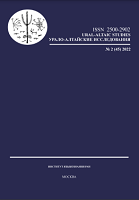Фрагмент лексической системы казымского диалекта хантыйского языка: глаголы pitti ‘упасть, попасть’ и χɔjti ‘задеть, попасть’ и их аргументная структура
A fragment of the lexical system of Kazym Khanty: the verbs pitti ‘to fall; to get into somewhere’ and χɔjti ‘to touch; to hit the target’, and their argument structure
Author(s): Daria A. RyzhovaSubject(s): Lexis, Semantics
Published by: Институт языкознания Российской академии наук
Keywords: Khanty language; lexical semantics; lexical typology; argument structure; semantic continuity;
Summary/Abstract: The study describes the semantics of the Kazym Khanty verbs pitti ‘to fall; to get into somewhere’ and χɔjti ‘to touch; to hit the target’ as analyzed from the perspective of the frame-based approach to lexical typology. According to this approach, semantic fields consist of certain situation types, or frames, which are denoted by the lexemes belonging to the field. The situation types correspond to distributional patterns and serve as a basis for cross-linguistic comparison of word meanings. The paper identifies and illustrates the sets of physical meanings of the verbs in question, with a special focus on the domain of variation between pitti and χɔjti. It is shown that these verbs concur in contexts involving the semantics of either getting (occasionally) into somewhere (cf. A fly got into my soup) or hitting the target (cf. The arrow hit him in the arm). Evidence from Kazym Khanty, as well as from available cross-linguistic data, suggests that these meanings are adjacent to each other, while the meaning ‘to get into somewhere’ is closer to the domain of falling, and the meaning ‘to hit the target’ is closer to the domain of physical contact. Thus, the meanings ‘to fall’, ‘to get into somewhere’, ‘to hit the target’, and ‘to touch’ form a semantic continuum with no clear-cut boundaries between the semantic fields. This hypothesis is further supported by morphosyntactic variation in encoding of the patientive argument of the verb χɔjti, which seems to be influenced by the morphological pattern inherent to the verb pitti.
Journal: Урало-алтайские исследования
- Issue Year: 2022
- Issue No: 02 (45)
- Page Range: 123-140
- Page Count: 18
- Language: Russian

